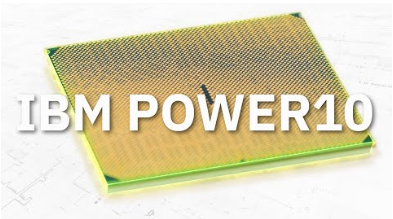 IBM today announced a new IBM POWER10 CPU family, its first 7nm form factor platform, built with Samsung, designed for enterprise hybrid cloud computing with up to 3x greater processor energy efficiency, workload capacity, and container density than its predecessor, according to the company.
IBM today announced a new IBM POWER10 CPU family, its first 7nm form factor platform, built with Samsung, designed for enterprise hybrid cloud computing with up to 3x greater processor energy efficiency, workload capacity, and container density than its predecessor, according to the company.
According to IBM, POWER10 highlights include:
- Support for multi-petabyte memory clusters with a new technology called Memory Inception, designed to improve cloud capacity for memory-intensive workloads from ISVs such as SAP, the SAS Institute and large-model AI inference.
- Hardware-enabled security, including transparent memory encryption with quadruple POWER9’s AES encryption engines per core in anticipation of future cryptographic standards like post-quantum and fully homomorphic encryption. It also brings new enhancements to container security.
- New processor core architectures with an embedded Matrix Math Accelerator extrapolated to provide up to 20x faster AI inference for FP32, BFloat16 and INT8 calculations per socket than the POWER9.
“Enterprise-grade hybrid clouds require a robust on-premises and off-site architecture inclusive of hardware and co-optimized software,” said Stephen Leonard, GM of IBM Cognitive Systems. “With IBM POWER10 we’ve designed the premier processor for enterprise hybrid cloud, delivering the performance and security that clients expect from IBM. With our stated goal of making Red Hat OpenShift the default choice for hybrid cloud, IBM POWER10 brings hardware-based capacity and security enhancements for containers to the IT infrastructure level.”
 IBM said POWER10 offers hardware-enforced container protection and isolation capabilities co-developed with the POWER10 firmware. “If a container were to be compromised, the POWER10 processor is designed to be able to prevent other containers in the same virtual machine from being affected by the same intrusion,” the company said. “To better … proactively defend against certain new application vulnerabilities in real-time, IBM POWER10 is designed to give users dynamic execution register control, meaning users could design applications that are more resistant to attacks with minimal performance loss.”
IBM said POWER10 offers hardware-enforced container protection and isolation capabilities co-developed with the POWER10 firmware. “If a container were to be compromised, the POWER10 processor is designed to be able to prevent other containers in the same virtual machine from being affected by the same intrusion,” the company said. “To better … proactively defend against certain new application vulnerabilities in real-time, IBM POWER10 is designed to give users dynamic execution register control, meaning users could design applications that are more resistant to attacks with minimal performance loss.”
In support of hybrid cloud and on-premises workloads deployments, IBM said POWER10 is designed to pool or cluster physical memory across POWER10-based systems (expected to be available second half of next year). Memory Inception is designed to allow POWER10-based systems in a cluster to access and share each other’s memory, creating multi-petabyte sized memory clusters, the company said.
More about IBM POWER10 can be found here.



